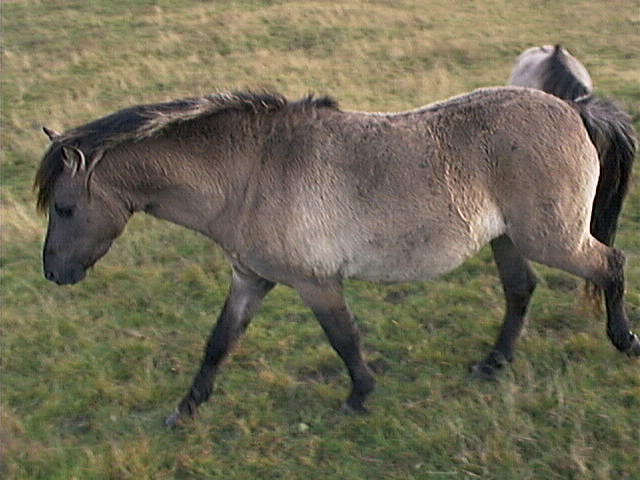Heck horses
are the only horse breed that actually is the result of breeding-back (the
Konik is not, as I explained here), except for the Hegardt horse (as far as I
know, this breed is merely a bunch of mustangs that were selected for a black
dun colour, that’s not enough in my view, and there aren’t any photos of this
breed avaiable). Often Heck horses are referred to as “bred-back Tarpans”,
especially in Germany. But is this labelling justifiable? Does the Heck horse
resemble the European wild horse better than other horse breeds?
The Heck
horse was created by (big surprise) the Heck brothers during the 1930s and
1940s. The Hecks crossed Icelandic horses, Gotland ponies and Dülmen ponies
with a Przewalski stallion, and subsequently Koniks from Poland were crossed
in. After WWII, more and more Koniks were merged into the breed, so that there
is only little difference between the Konik and many Heck horses [1]. However,
Heck horses are more heterogeneous and tend to have a larger and more gracile
phenotype. Towards the 1970s Heck horses were crossed with Przewalski horses
again in a zoo in North-Rhine Westphalia. As a result, some Heck horses have
upright manes today [1] (this trait, however, is unlikely for Holocene European
wild horses [2]).
Just like
the Konik, the Heck horse is a black dun breed, and thus representative of one
of five possible colour morphs within European wild horses. Bay dun, just as
authentic, does not appear as far as I know. Many Heck horses have a quite
light expression of their basic colour, resulting in a very light gray that is
not very likely for genuine wild horses because it is never mentioned in
historic references. Also, some Heck horses have typical riding horse
proportions and a long mane. Take a look at this Heck horse from the Munich Zoo
which barely has any wild horse features:
Nevertheless,
thanks to the high amount of Konik influence, there are Heck horses in grazing
projects which do have a wild horse-like stocky body and a brownish colour, the
Przewalski influence contributed a large robust head and a short mane. These
individuals are prime examples for what black dun Tarpans probably looked like (I can't link the first photo directly):
But,
considering the multifaceted origin of this breed, some individuals with a bit weird
appearance can show up as well (the colour in that one is OK, but it is too slender and the head shape is awkward):
To address
my question in the first paragraph: No, the Heck horse is not more Tarpan-like
than other primitive horse breeds, even if we look at the phenotype only. Its
population misses the other colour morphs of the Tarpan (bay dun, leopard
spotted, possible non-dun individuals) and both authentic and not authentic
individuals are present in this breed. Basically, modern Heck horses are Koniks with introgression from other horse breeds, they is not necessarily more
authentic than the Koniks are. What does that mean for creating a wild horse
substitute: one has to pick the best individuals out of that pool, just like in
any other suitable breed.
By the way,
there is no breeding book for the Heck horse, and German breeders often either
consciously or unintentionally mix Heck horses and Koniks, so that the two
breeds probably will be one pool in the future [1].
Literature:
[1] Bunzel-Drüke, Finck, Kämmer, Luick, Reisinger, Riecken, Riedl,
Scharf & Zimball: „Wilde Weiden: Praxisleitfaden für Ganzjahresbeweidung
in Naturschutz und Landschaftsentwicklung“. 2010
[2] Baker, Sue: Exmoor Ponies: Survival of the Fittest – A natural
history. 2008.




Great horses.
ReplyDelete